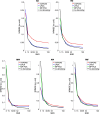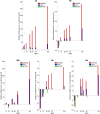ACID: A comprehensive toolbox for image processing and modeling of brain, spinal cord, and ex vivo diffusion MRI data
- PMID: 40800336
- PMCID: PMC12290833
- DOI: 10.1162/imag_a_00288
ACID: A comprehensive toolbox for image processing and modeling of brain, spinal cord, and ex vivo diffusion MRI data
Abstract
Diffusion MRI (dMRI) has become a crucial imaging technique in the field of neuroscience, with a growing number of clinical applications. Although most studies still focus on the brain, there is a growing interest in utilizing dMRI to investigate the healthy or injured spinal cord. The past decade has also seen the development of biophysical models that link MR-based diffusion measures to underlying microscopic tissue characteristics, which necessitates validation through ex vivo dMRI measurements. Building upon 13 years of research and development, we present an open-source, MATLAB-based academic software toolkit dubbed ACID:A Comprehensive Toolbox forImage Processing and Modeling of Brain, Spinal Cord, and Ex VivoDiffusion MRI Data. ACID is an extension to the Statistical Parametric Mapping (SPM) software, designed to process and model dMRI data of the brain, spinal cord, and ex vivo specimens by incorporating state-of-the-art artifact correction tools, diffusion and kurtosis tensor imaging, and biophysical models that enable the estimation of microstructural properties in white matter. Additionally, the software includes an array of linear and nonlinear fitting algorithms for accurate diffusion parameter estimation. By adhering to the Brain Imaging Data Structure (BIDS) data organization principles, ACID facilitates standardized analysis, ensures compatibility with other BIDS-compliant software, and aligns with the growing availability of large databases utilizing the BIDS format. Furthermore, being integrated into the popular SPM framework, ACID benefits from a wide range of segmentation, spatial processing, and statistical analysis tools as well as a large and growing number of SPM extensions. As such, this comprehensive toolbox covers the entire processing chain from raw DICOM data to group-level statistics, all within a single software package.
Keywords: BIDS; SPM12; artifact correction; biophysical modeling; brain and spinal cord; diffusion MRI.
© 2024 The Authors. Published under a Creative Commons Attribution 4.0 International (CC BY 4.0) license.
Conflict of interest statement
The authors declare no competing interests.
Figures














References
-
- Ades-Aron , B. , Veraart , J. , Kochunov , P. , McGuire , S. , Sherman , P. , Kellner , E. , Novikov , D. S. , & Fieremans , E. ( 2018. ). Evaluation of the accuracy and precision of the diffusion parameter EStImation with Gibbs and NoisE removal pipeline . NeuroImage , 183 , 532 – 543 . 10.1016/j.neuroimage.2018.07.066 - DOI - PMC - PubMed
LinkOut - more resources
Full Text Sources
Research Materials
Miscellaneous
